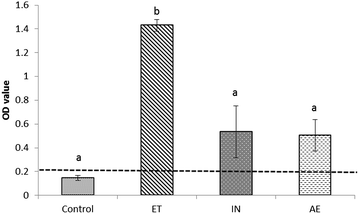Induction of mycoplasmal pneumonia in experimentally infected pigs by means of different inoculation routes
- PMID: 27160189
- PMCID: PMC4862235
- DOI: 10.1186/s13567-016-0340-2
Induction of mycoplasmal pneumonia in experimentally infected pigs by means of different inoculation routes
Abstract
The purpose of this study was to assess the effect of three different inoculation routes into mycoplasmal pneumonia (MP) in pigs challenged with Mycoplasma hyopneumoniae (M. hyopneumoniae). Thirty six-week-old M. hyopneumoniae seronegative piglets were randomly assigned to four groups: three challenged groups with experimentally inoculated pigs by either the endotracheal (ET; n = 8), intranasal (IN; n = 8) or aerosol (AE; n = 8) routes and one uninfected group (Control; n = 6). Blood samples were collected 1 day before challenge and at necropsy, 28 days post-inoculation (dpi), to assess seroconversion. Laryngeal swabs were collected at -1, 7, 14, 21 and 28 dpi in order to evaluate colonization. At necropsy, lung lesions were scored and lung tissue was collected for histopathological studies and M. hyopneumoniae DNA detection. Broncho-alveolar lavage fluid (BALF) was also obtained to detect M. hyopneumoniae DNA, specific IgA antibodies and cytokines. MP was observed in all inoculated groups, but the ET group displayed a significantly higher number of animals affected by MP as well as a higher mean lung lesion score. These results were paralleled with an earlier seroconversion and upper respiratory tract colonization of M. hyopneumoniae. Additionally, in the ET group, higher levels of pro-inflammatory cytokines and specific IgA antibodies in BALF were found. Under the conditions of the present study, MP was reproduced by the three evaluated inoculation routes. Obtained results suggest that the ET route is the most effective in order to induce MP in pigs experimentally challenged with M. hyopneumoniae.
Figures



References
-
- Thacker EL, Minion FC. Mycoplasmosis. In: Zimmerman JJ, Karriker LA, Ramirez A, Schwartz K, Stevenson GW, editors. Disease of swine. New York: Wiley; 2012.
-
- Irigoyen LF, Van Alstine W, Turek J, Clark LK. Ultrastructural observation of the airways of recovered and susceptible pigs after inoculation with Mycoplasma hyopneumoniae. Pesq Vet Bras. 1998;18:1–7. doi: 10.1590/S0100-736X1998000100001. - DOI
-
- Villarreal I, Maes D, Meyns T, Gebruers F, Calus D, Pasmans F, Haesebrouck F. Infection with a low virulent Mycoplasma hyopneumoniae isolate does not protect piglets against subsequent infection with a highly virulent M. hyopneumoniae isolate. Vaccine. 2009;27:1875–1879. doi: 10.1016/j.vaccine.2008.12.005. - DOI - PubMed
Publication types
MeSH terms
LinkOut - more resources
Full Text Sources
Other Literature Sources
Miscellaneous

